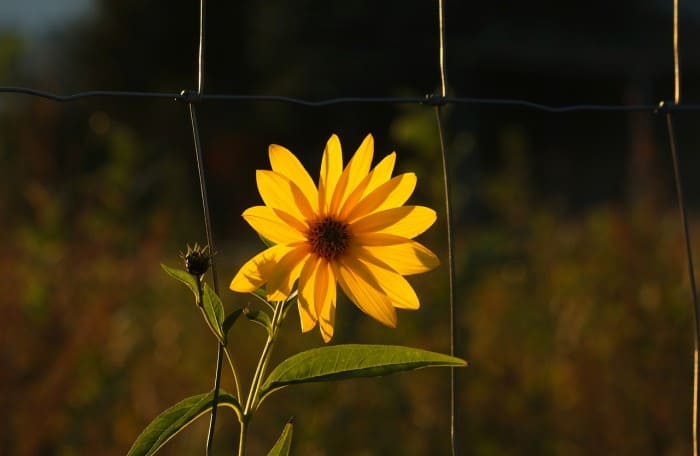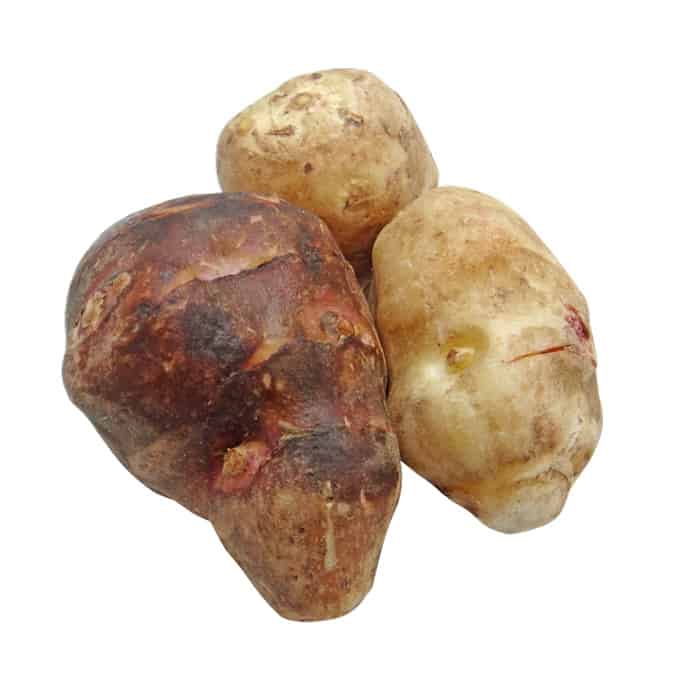Growing Jerusalem artichokes can keep both your and your survival livestock well fed during a long-term disaster – with barely any manual labor from you required in the process.
A single Jerusalem artichoke plant is capable of producing 200 pounds of nutrient-rich tubers that is safe for both humans and livestock to eat.

Jerusalem Artichoke History
Two centuries ago, Native Americans planted Jerusalem artichokes along their seasonal migration trails to ensure the members of the tribe would always have a food source available during their travels. Native Americans referred to the tubers as “sunroots”.
Theories vary on how this perennial vegetable plant became known as the Jerusalem artichoke. It is not a member of the artichoke family nor does it have any known connection to the Holy city.
The moniker may have come about as a distortion of the name, “Girasole Articiocco” which was how sunchokes were first referred when a Catholic cardinal in Rome in 1617. Girasole is Laton for sunflower.
Once the tubers were picked them from the garden and shared them with the Pope.
All of the recently discovered vegetable plants were rumored to have been given to the Pope so he could gift them to friends, so they too could cultivate the tasty crop.
Sunchokes did not gain popularity outside of the Rome region until French chefs at upscale restaurants in the 18th and 19th centuries. One of the famous French chefs, Louis Eustache Ude, is credited with creating the signature Jerusalem artichoke dish as part of his Palestone soup recipe that is still popular on dinner tables in France.
Sunchokes became a common ingredient in stews and other meat dishes in both the United States and Europe during the 17th century. During World War II, wartorn France began eating and cultivating Jerusalem artichokes extensively due to the lack of available food in the region.
The tubers are still a staple garden item i in the south of France.

What Is a Tuber?
A tuber is not some weird food source that you would only force yourself to eat during a survival situation. If you have ever eaten a potato, you have consumed a tuber.
A tuber is merely the swollen portion of a plant stem that is found underneath the ground.
What are Jerusalem Artichokes?
This nutrient-rich plant is also commonly referred to as sunchokes. Not too long ago, I heard a survival homesteader refer to Jerusalem artichokes as the “invasive weed you need to plant”.
While it is true sunchokes are often deemed both lowly weeds and invasive, the benefit these plants can bring to your survival plan far outweigh any cutting back chores involved – if you even want to cut them back.
These hardy plants do spread as quickly as greenbriers and honeysuckle vines but, from a survival gardening perspective, I consider that a very good thing.
I have never either personally seen or read about any vegetable plants that grows as quickly as sunchokes – or requires less tending once it is placed in the ground.
This really is a plant it and forget it type of plant, fellow preppers. The most important growing tip anyone could offer regarding Jerusalem artichokes it to choose a sunny spot where you put them wisely… Because they will grow and grow and grow and fill up as push through as much space as allowed.
I wouldn’t classify sunchokes among the best natural fencing options because they do not offer bariers or any other prickly parts to deter entry, and your livestock will eat on the plant up through the early winter months.
But, if you are merely looking to obscure the view from the outside, planting rows of sunchokes along the border of your property will certainly make short work of their assigned task.
Quick Facts
- Sunchokes are extremely high in potassium. A single tuber offers 643 milligrams of potassium.
- Jerusalem artichokes look a lot like ginger, but have a texture that is more akin to water chestnuts.
- This nutrient rich plant boasts a nutty and sweet flavor.
- Sunchokes range in size from 2 to 4 inches, on average, and have a thin skin.
- Jerusalem artichokes are members of the sunflower family, and are often dubbed the root version of this bright and tall plant.
- The exterior flesh is ivory to orange color.
- The inside flesh of the Jerusalem artichoke tuber is white.
- When bitten into, sunchokes taste crisp.
- Jerusalem artichokes can be eaten year-round, but their growing season has two peaks – in both the spring and fall.
- They can be eaten either raw or cooked any time of the year.
- Jerusalem artichokes are one of the few vegetables that grow naturally in the United States, and journey back across the sea with early explorers.
- Jerusalem artichokes are also referred to as earth apples, sunroots, and topinambours.
- The tubers are inulin rich, meaning they contain no other types of carbohydrates at all. Because of this unusual composition of the tubers are often dubbed “the diabetic’s potato”.
- Jerusalem artichoke tubers boast a higher potassium and fiber count than the majority of other vegetables that are native to North America.
- The plants is a member of the Helianthus genus.
- Jerusalem artichokes commonly reach heights of up to 15 feet tall.
- Both the petals and leaves on the plant look a lot like smaller versions of sunflower leaves and petals.
- The yellow flower petals on sunchokes do not bloom until late in the summer.
- These plants growing in the United States may have originated along the Ohio River and the Mississippi River.
Jerusalem Artichokes Survival Value
It is common for just one Jerusalem artichoke plant to produce as few as 75 but as many as 200 tubers during only a single growing season.
Because the tubers grow beneath the ground throughout the entire year in almost any environment, preppers can have an active survival garden at all times. The plants are perennials, so you can have repeat growing seasons year after year as the sunchokes reseed themselves.
They are the ultimate low to no maintenance plant. There is no reason to weed around the plant nor do you have to right birds and other critters for the bounty it produces since the tubers grow beneath the ground.
Jerusalem artichokes will not only grow but thrive in nearly any environmental conditions and in any type of soil. Sunchokes are also exceptionally drought resistant, so there is not need to haul water out to your back pasture if the weather turns against you.
Even if all of your other plants perish due to drought or a seasonal storm, your family will still have food to eat.
Feeding your survival livestock during a SHTF event is also a top priority. By planting Jerusalem artichokes along your fence line or in an area that is fenced off until needed, your horses, goats, sheep, hogs, cattle, rabbits, and poultry birds will also have a nutrient rich food source.
The leaves, stems, and blossoms of this attractive plants will be available for livestock eating well into the late weeks of fall – long after the last blade of grass have been eaten from the pasture.
Hogs are also prone to rooting around, and digging up the tubers to eat all by themselves.
Sunchoke Nutritional Value
Jerusalem artichokes contain a substantial amount of protein, trace minerals, electrolytes, potassium, fiber, and the prebiotic inulin – which may be why they are often used as a base ingredient in natural home remedies.
Inulin could excel the growth of bifidobacteria, which is a “good bacteria” which could help stop harmful bacteria from growing, and might help reduce some types of carcinogenic enzymes.
Sunchokes boast a higher percentage of protein than beans, corn, wheat, or soybeans. The edible leaves and stems on the perennial vegetable plant are comprised of approximately 28% protein… that is roughly twice the protein content found in corn.
The tubers are also comprised of lesser amounts of pantothenic acid, thiamin, riboflavin, and pyridoxine – B complex vitamins, and folates.
Jerusalem artichokes might aid in the lowering of blood pressure by have a countering effect on the sodium consumed through other foodstuffs.
Jerusalem Artichokes Growing Tips
- The tubers should be planted after the threat of the last hard frost has passed in the spring. In most agricultural growing zones, Jerusalem artichokes are planted from the middle of March through early April.
- Before planting the sunchokes in the still cold and hard ground, till the soil at least once to break it up and stir up the nutrients below the upper level of the soil.
- Make sure each tuber boasts an “eye” just like potatoes or it will not grow. Even a tiny bit of a tuber should grow as long as it has an eye.
- Plant the tubers at a minimum of four inches deep, but do not exceed six inches. Till the ground to turn it, and expose the nutrient-rich and softer soil below. While you can start them in a container and relocate them into the ground, they do not transplant well.
- Space the tubers at least 12 inches apart.
- These plants prefer full sun. They will grow in a bushy manner like a shrub. If planting in rows, space them five feet apart.
- Sunchokes will mature in 90 days.
- They are recommended for best growing in USDA Agricultural Zones 3 through 9.
- Jerusalem artichokes can be grown outdoors in hotter climates, but should be moved indoors during the summer months (or at least in a shady spot). Expect a lesser yield when growing in hotter climates.
- They can also be started inside in a container, and transplanted quite easily due to their hardy nature. You can also grow them in a deep pot or bucket that is at least of a 5-gallon capacity.
- Because of the extreme height and bushy nature of sunchoke plants, they really should not be situated near your more traditional garden crops because they will throw too much shade.
- If planting near other tall garden crops you might consider using the sunchokes as a companion crop for corn or pole beans – as the Native Americans did.
- If you are planting the Jerusalem artichokes in a colder climate than recommended or experiencing unseasonably cold temperatures, mulch around the young plants when they first peek up out of the soil to protect them from a late light frost and wind chill.
Sunchoke Varieties
- Fuseau – This variety of Jerusalem artichokes have a robust smoky flavor. The tubers are generally larger and smoother. Fuseau growers often exceed the 200 pounds per year sunchoke yield.
- Sugarball – Theses tubers are smaller and whiter than the other varieties. Although the weight of the yield will be lessened, sugarball Jerusalem artichokes taste absolutely delicious when roasted.
- White French Mammoth – This variety of tubers are both exceptionally large and incredibly knobby, making peeling them a bit of a fight…. but worth it.
Jerusalem Artichoke Harvesting Tips
- During both the spring and fall the inulin content in the tubers is at its highest point. Sunchokes being used for this property or in natural home remedies are often harvested at these two seasonal peaks.
- At the end of the growing season you will know the plants are fully matured when the flowers disappear and the stalks start to fall over. This is the time to turn your survival livestock loose on the plants and allow them to eat their fill.
- To harvest the tuber, simply dig them out of the ground manually or with agricultural attachments on a tractor like you would do with potatoes.
- It does not hurt at all to leave the mature tubers in the ground as a means of preservation as long as the Jerusalem artichoke plant does not show any signs of rotting or disease. Some growers swear that allowing the sunchoke tubers to remain in the dirt until after a frost – or sometimes two, has passed, will significantly sweeten the taste.
- To preserve Jerusalem artichoke tubers for longer than 12 months in the ground, cover them with one foot of good mulch to protect them from either repeated light frosts or a single hard frost. If you dig up frozen tubers, they should be pitched into the compost pile and not used for human consumption.
- Never wash or peel the harvested tubers until you are ready to eat them or mix them into a home remedy – they discolor and get mushy rather easily.
Sunchoke Plant Diseases and Destructive Insects
No plant is 100% immune to bad bugs and plant diseases, but it seems the Jerusalem artichoke comes dang close.
When attacked by any common garden bug or plant disease I have ever come across in my many years gardening in USDA Agricultural Zone 6, all that ever happened was stunted growth and a lesser yield – even the dreaded Japanese beetle!
Sunchokes are simply the mosts difficult to kill plant that I have ever come across. Drought, excessive rain, poor soil, high winds, light flooding, destructive bugs, and plant disease all seems to be taken in stride.
The only true enemy of Jerusalem artichokes appears to be a lack of sunlight or cramped growing space.
How to Use Jerusalem Artichokes
- The tubers from the sunchoke plant can be used as a potato substitute in virtually any recipe. But, because Jerusalem artichokes contain far less moisture than potatoes and no starch, cooking times will need to be played around with a bit when making recipes.
- Tubers can be served raw as part of a salad – especially a foraged salad.
- One of the most popular (and dare I say, tastiest) way to eat Jerusalem artichoke tubers is to roast them.
- The tubers are typically scrubbed in cold water just like potatoes, and then the skin is peeled before use – unless roasting.
- Harvested Jerusalem artichokes keep in a refrigerated environment for about 30 days if they are kept in a plastic bag with holes poked into it. They can be kept for far longer periods of time in a root cellar environment just like potatoes and carrots.
- The tubers can be mashed like potatoes, and also used as a main ingredient in casseroles.
- Sauteed sunchokes are also a popular way to consume these nutrient rich vegetables. Toss on a few pinches of your favorite spices before either sauteing or roasting the tubers for added taste and nutrients. I highly recommend using garlic, oregano, black pepper, or paprika.
- It takes a little bit of work and/or a good juicer, but the tubers can be turned into a sweet juice or even be used in wine or mead making.


Tara Dodrill is a homesteading and survival journalist and author. She lives on a small ranch with her family in Appalachia. She has been both a host and frequent guest on preparedness radio shows. In addition to the publication of her first book, ‘Power Grid Down: How to Prepare, Survive, and Thrive after the Lights go Out’, Dodrill also travels to offer prepping tips and hands-on training and survival camps and expos.

Guarantee you one survival plant that WILL outgrow and out produce sun chokes: kudzu!
We saw real kudzu when traveling, wish I could get some for my Greenhouse to feed to livestock in winter. Here in Ohio we have chickweed that takes over our garden in fall & spring, doesn’t grow in the heat. We call it “arctic kudzu”.
Lol, yes Kudzu is a rapid grower, that is for sure!
Thank you for your information. I remember eating Jerusalem artichokes as a kid and loved them. Now I want to plant them for both our consumption and my small goat herd. Living in west Texas panhandle we need something besides hay and feed pellets to supplement the goats since our rain in few and far between.